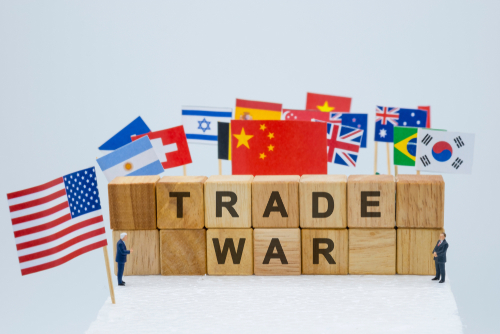Canada, Mexico, and China Strike Back: Retaliatory Tariffs
President Donald Trump's latest move to impose sweeping tariffs on Mexico, Canada, and China has triggered immediate retaliatory measures from all three nations. The 2025 tariffs, which are scheduled to take effect this Tuesday, are already sending shockwaves through global markets, threatening to disrupt decades of tightly integrated supply chains and drive up consumer prices in the United States.
With trade relationships between the U.S. and its closest partners in jeopardy, the potential fallout has economists and businesses on edge. Here's an in-depth look at the retaliation from Canada, Mexico, and China, their potential impact, and what lessons can be drawn from Trump's previous tariff wars in 2018.
Canada's Response: Retaliation and Consumer Boycott
Canadian Prime Minister Justin Trudeau condemned Trump's decision as a direct attack on Canada's economy and its long-standing alliance with the United States. In a televised speech, Trudeau urged Canadians to refrain from buying American-made goods and outlined a two-phase retaliatory tariff strategy.
Targeted Sectors:
Canada's retaliatory tariffs are set to target a broad spectrum of American goods, including:
- Agricultural products such as beef, poultry, and dairy
- Consumer goods like household appliances
- Manufactured items, including automotive parts
Trudeau made it clear that Canada would not sit idle while its economy and trade relationships were undermined. "The tariffs are unjustified, misplaced, and harmful to both Canadians and Americans. We will protect our industries and stand firm against this aggression," he stated.
To cushion the blow on Canadian businesses, Trudeau's government has announced a relief fund for affected sectors. Canadian businesses have voiced concerns over potential job losses and supply chain disruptions, particularly in the manufacturing and automotive sectors.
Mexico’s Countermeasures: Tariffs and Strong Criticism
Mexican President Claudia Sheinbaum responded swiftly, criticising the U.S. for what she described as a "punitive and ineffective" approach to international relations. In a fiery post on X, Sheinbaum highlighted Mexico's extensive efforts to curb drug trafficking and migration, calling Trump's actions unjust and counterproductive.
Mexico’s Retaliatory Measures:
- Tariffs on key American agricultural exports, including corn and pork
- Duties on automotive parts and industrial machinery
- Levies on consumer goods such as electronics
"Problems are not resolved by imposing tariffs but by talking and engaging in dialogue," Sheinbaum remarked. Economists warn that the tariffs could push Mexico’s already fragile economy into recession, leading to rising unemployment and increased migration to the United States.
Economic Risks:
Mexico's economy is heavily dependent on trade with the U.S., with exports and imports accounting for nearly 90% of its GDP. A report from Moody’s Analytics predicts that if the tariffs persist, Mexico’s currency will depreciate, inflation will rise, and the country could face its worst economic downturn in decades.
China’s Response: WTO Complaint and Strategic Countermeasures
China, already embroiled in trade tensions with the U.S. since Trump's first term, announced a series of strategic countermeasures in response to the 10% tariffs on all Chinese imports. The Chinese Ministry of Commerce confirmed that it would lodge a formal complaint with the World Trade Organization (WTO) and impose "corresponding duties" on American exports.
Key Targets:
China is expected to focus on high-profile American exports, including:
- Agricultural products like soybeans and corn
- Technological goods such as semiconductors
- Industrial machinery and luxury goods
Chinese officials have also hinted at potential restrictions on rare earth exports, which are crucial for the U.S. technology sector. The move could have severe implications for American industries reliant on these critical materials.
China's response underscores its continued willingness to challenge U.S. trade policy on the global stage. The tariffs are likely to exacerbate supply chain disruptions and further fuel inflationary pressures in the United States.
Economic Fallout for the United States
The impact of the tariffs is expected to be swift and widespread, with American consumers bearing the brunt of the cost increases. Trade experts predict that prices for fresh produce, automotive parts, and household goods will rise in the coming weeks.
Immediate Consequences:
- Agricultural Products: American farmers, already struggling from previous trade disputes, are likely to face reduced demand for exports and falling prices.
- Automotive Sector: Car prices are expected to rise as manufacturers grapple with higher costs for imported parts from Mexico and Canada.
- Consumer Goods: Electronics, clothing, and household items will see price hikes as supply chains are disrupted.
Jock O’Connell, a trade expert at Beacon Economics, warned, "Foreigners don’t pay the tariffs; American businesses and consumers do."
The automotive industry, in particular, is facing significant challenges. Parts often cross borders multiple times during the manufacturing process, and the tariffs will drive up production costs.
Gas prices are also expected to rise, particularly in regions dependent on Canadian oil imports.
Related: Has Trump started a Trade War?
Related: Tariffs Threaten to Decimate U.S. Businesses: A Crisis Looms
Lessons from the 2018 Trade War: A Cautionary Tale
This isn't the first time Trump's trade policies have sparked international backlash. In 2018, his administration imposed tariffs on hundreds of billions of dollars' worth of Chinese imports, prompting a retaliatory response from Beijing.
Consequences of the 2018 Trade War:
- Economic Strain:
American farmers were among the hardest hit, with China cutting its purchases of U.S. agricultural products, particularly soybeans. The federal government had to issue billions in bailout payments to struggling farmers. - Price Increases:
Consumers faced higher prices for electronics, clothing, and other goods, contributing to inflationary pressures. - Business Disruptions:
Many companies had to restructure their supply chains to cope with the tariffs, leading to increased operational costs and reduced competitiveness.
A 2019 report by the Federal Reserve found that the tariffs ultimately led to higher prices for consumers and reduced income for American farmers and manufacturers.
Broader Implications for Trade and Diplomacy
The latest tariffs threaten to unravel decades of economic integration and cooperation between the United States, Canada, and Mexico. The US-Mexico-Canada Agreement (USMCA), which replaced NAFTA, was supposed to stabilise trade relations between the three nations. Trump's tariffs now undermine that agreement and risk creating long-term economic and political rifts.
China’s retaliation could also have significant implications for global trade. As the world’s second-largest economy, China may seek to build alliances with other trading partners to counter American pressure.
Potential Pathways to Resolution
Despite the tense situation, there may still be room for negotiation. Trump's tariffs have often been used as a bargaining chip to extract concessions from other countries.
However, experts warn that prolonged trade disputes could have severe economic consequences for all parties involved. The international community will be closely watching to see whether diplomatic efforts can prevent a full-blown trade war.
In the meantime, businesses and consumers on both sides of the border are bracing for impact. The coming weeks will be crucial in determining the future of North American and global trade relations.
For now, the world watches as retaliatory tariffs threaten to reshape international trade and economic stability.
Conclusion
Trump's latest tariff war suggests a troubling disregard for the lessons of 2018, when his aggressive trade policies backfired spectacularly. The economic strain, higher consumer prices, and diplomatic fallout from that debacle should have served as a cautionary tale. Instead, Trump is doubling down, risking fresh economic turbulence and fraying long-standing alliances with Canada, Mexico, and China. The cost? Skyrocketing prices for American families, potential recessions abroad, and a fractured global trade landscape. Tariffs may be a blunt political weapon, but history shows they leave everyone wounded.









